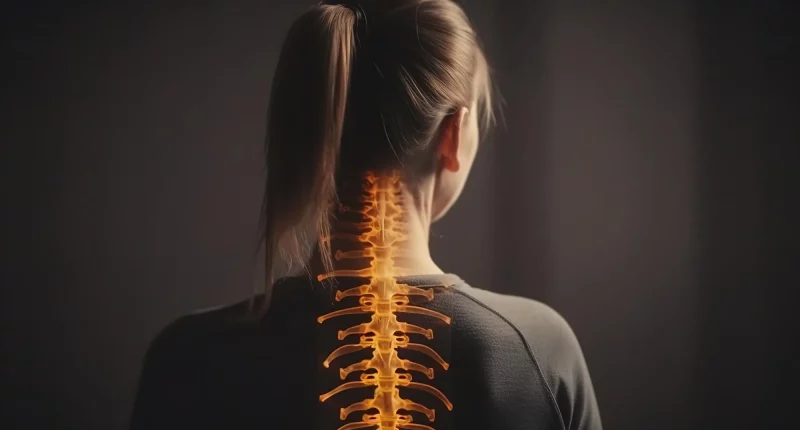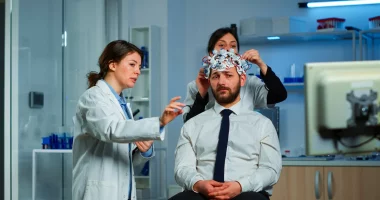Cervical spondylosis is a condition that affects the neck and is often referred to as neck arthritis, cervical arthritis, or degenerative osteoarthritis. It involves the gradual wear and tear of the vertebrae (bones), discs, and ligaments in the cervical spine, which is the top area of the spine that runs through the neck.
The cervical spine is made up of seven vertebrae that start at the base of the skull. As cervical spondylosis progresses, bone spurs, known as osteophytes, can form on the edges of the vertebrae. The discs in the middle of the vertebrae become thinner over time and lose their ability to cushion the spine. This can heighten the chance of experiencing symptoms.
Many individuals with cervical spondylosis do not have any noticeable symptoms. If symptoms do appear, they usually improve over time with non-surgical treatments. In some cases, if symptoms are serious or persistent, a healthcare provider may suggest surgery as a treatment option.
Causes
The condition called Osteoarthritis is the main cause of cervical arthritis. It happens when the cartilage that pads the joints starts to break down, mostly because of everyday use and aging. This degeneration of cartilage leads to pain and stiffness in the cervical spine, which is the neck area of the spine
Several factors can worsen the effects of this wear and tear. These include genetic predispositions, lifestyle choices, and epigenetics, which are environmental influences that can affect how genes function. Additionally, sex and ethnicity may play a role in the risk of developing cervical arthritis. However, the most significant risk factor for osteoarthritis is aging.
Although less common, other forms of arthritis, like rheumatoid arthritis, can also impact the cervical spine.
Risk Factors
Several factors can increase the risk of developing cervical arthritis. A family history of the condition may suggest a genetic predisposition. As people age, their risk of cervical arthritis naturally increases due to the gradual wear and tear on the joints over time. Repeated injuries or frequent use of the neck can also contribute to the development of the condition.
Lifestyle factors such as smoking and obesity can further heighten the risk. Additionally, chronic health issues like diabetes and hypertension are associated with a greater likelihood of developing cervical arthritis. Managing these risk factors can help decrease the chances of experiencing cervical arthritis or mitigate its effects.
Symptoms
Cervical spondylosis does not always present noticeable symptoms. When symptoms do occur, the most common one is neck pain, which may also radiate to other areas such as the shoulders or head.
Other symptoms can include neck stiffness, swelling, and muscle spasms. Individuals may experience headaches, balance issues, and difficulty walking. Movements might become stiff or posture might change, and some individuals may feel a popping sensation when moving their neck. Additionally, weakness in the hands and legs, as well as a reduction in dexterity, can occur.
In some cases, cervical spondylosis can compress blood vessels, which may impact blood flow to the brain. This can lead to dizziness and, in severe cases, fainting.
Diagnosis
To diagnose cervical arthritis, healthcare will first consider an individual’s signs, age, and determinants. They typically start with a physical examination and a review of the patient’s medical history. During the physical exam, the healthcare provider evaluates various aspects, including touch sensation, gait and posture, reflexes, arm and neck flexibility, and strength in the hands and arms.
Imaging tests are also crucial for diagnosing the condition. An X-ray can show damage to the spine and any bone spurs that may be present. MRI scans provide detailed pictures of nerves, muscles, and the spinal cord, helping to detect soft tissue damage. A myelogram includes inserting a colored dye into the spinal canal to enhance the visibility of nerve roots and other structures, followed by a CT scan. It offers a more detailed view of the cervical spine’s bony structure compared to X-rays.
In addition to imaging, nerve conduction studies and electromyography are used to assess the functionality of specific nerves, and muscles. Blood work may also be performed to exclude infectious arthritis and possible causes of pain in the joint.
Nonsurgical Treatments
To alleviate symptoms of cervical spondylosis, several nonsurgical treatments can be effective. Along with suggested exercises, individuals can try various home remedies. Over-the-counter medicines like acetaminophen or nonsteroidal anti-inflammatory drugs can provide relief. However, individuals with asthma, liver or kidney disease, heart conditions, hypertension, or stomach issues history should avoid NSAIDs. For serious pain, a healthcare provider might suggest stronger pain relief medicines.
Additional nonsurgical options include physical therapy, which helps improve mobility, manage pain, and increase physical activity. Suggested medications, such as muscle relaxants (e.g., cyclobenzaprine) or certain antidepressants, may be used to address neck tightness and spasms. Applying a cold pack or heated pad can also help soothe sore neck muscles.
A neck brace might offer temporary relief but should only be worn for short periods to avoid weakening neck muscles. For those with rheumatoid arthritis, disease-modifying agents may be recommended as a primary treatment. Injections, including corticosteroid or spinal epidural injections, can provide pain relief if other treatments are ineffective. For infectious arthritis, appropriate antiviral or antibiotic medications are prescribed to address the main infection. While these treatments are effective for less severe cases, individuals with severe neck pain should consult a healthcare provider.
Surgical Treatments
In cases where symptoms of cervical spondylosis progress to conditions like radiculopathy or myelopathy, surgery may be considered. Myelopathy involves spinal cord compression, while radiculopathy involves nerve root compression.
Surgical options for cervical arthritis may include discectomy to eliminate herniated discs, spinal fusion to alleviate pressure on the spinal cord and nerve roots, and bariatric surgery if weight impacts arthritis severity. Studies on the effectiveness of these surgeries have produced mixed outcomes. Therefore, it is crucial for patients to discuss the potential benefits and risks of surgery with their healthcare provider and to consider all nonsurgical treatments before opting for surgery.
When to Contact a Healthcare Provider
Back and neck pain can stem from various conditions, and it is difficult for someone to accurately determine osteoarthritis on their own. Additionally, if someone has a different kind of arthritis, like rheumatoid arthritis, starting treatment early can lead to better outcomes.
You should see a healthcare provider if:
- You have neck pain along with symptoms of an infection, like fever or feeling generally unwell.
- Your symptoms do not enhance after some days of trying self-care methods.
- The treatment you are using for arthritis is not helping or is leading to painful side effects.
- Your signs suddenly get much worse.
In these cases, a healthcare provider can provide a proper diagnosis and suggest the best course of action for treatment.
Summary
Cervical spondylosis, also known as neck arthritis, is caused by the wear and tear of the cervical spine’s discs, bones, and ligaments. Risk factors include aging, lifestyle, genetics, and certain health conditions. Symptoms can include stiffness, neck pain, and muscle spasms, with serious cases potentially affecting balance and causing dizziness. Nonsurgical treatments involve medications, physical therapy, and lifestyle adjustments, while surgery may be considered for many cases with spinal compression. It’s essential to consult a healthcare provider if symptoms are persistent, worsen suddenly, or if there are signs of infection.








